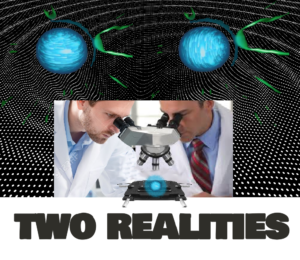More Than One Reality Exists

Different observations of the same reality (in photons) may both be correct
What is these laws of reality are not real. What if two versions of reality exist at the same time?
Martin Ringbauer, a postdoctoral researcher at the University of Innsbrück in Austria, is a coauthor of a report in the physics journal arXiv. Martin and a colleague set up an experiment where they both could look at the same photo at the same time. One saw the photon spin horizontally, the other saw the amse photon, at the same moment, spin vertically. Martin remarked “”You can verify both of them.” The two conflicting realities were both true.
So, at least at this level the Greeks were wrong. 1 plus 1 may not equal two if each 1 may be a zero
Physicists call this idea of simultaneous reality “superposition.” Elemental particles can exist simultaneously in two different states. Worse, this truth is not just a vagary of observation. If the guy on the right above measures the photon and it is rotating vertically, thge particle will now have that property for the guy on the left. the property of this photon is fixed. The reality of the two observers diverges but both are correct.
To ake this even more diffiult for ordinary humans, the Austrian physicists tested this theory using two pairs of entangled photons, meaning that their fates were linked. Entangled Knowing the state of one entangled photon automatically tells you the state of the other. You can read more about that at LiveScience.
“It seems that, in contrast to classical physics, measurement results cannot be considered absolute truth but must be understood relative to the observer who performed the measurement,” Ringbauer said.
Reality is the aggregate of all that exists or existent, as opposed to that which is imaginary. The scientific method is a recent development, the Greeks came close, but at best they developed scientific realism. And western religion has been pretty good at ignoring reality. What has been more important is one religion being able to perform more miracles. Christianity replaced the Roman religion because of the perceived miracles it performed. Barbarians not raping women in churches in Rome when they invaded Rome is one such miracle. And then there were dark ages. The fact that the learned men of the period were often monks and priests did put stresses on the Church.
Of course the Greeks did have thought experiments that are akin to these modern conundrums. Take two identical boats and take from each boat a part and replace it with a part from the other boat. When all the possible parts are replaced, which boat is the original boat. Then there is Schrodinger’s cat here two realities are possible until you open the box.